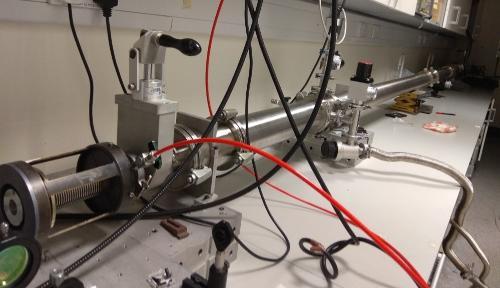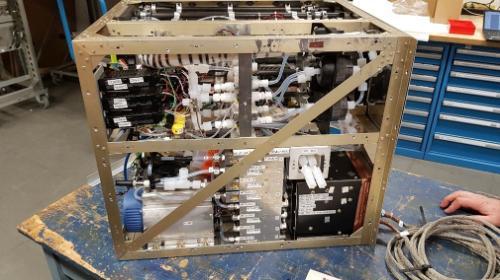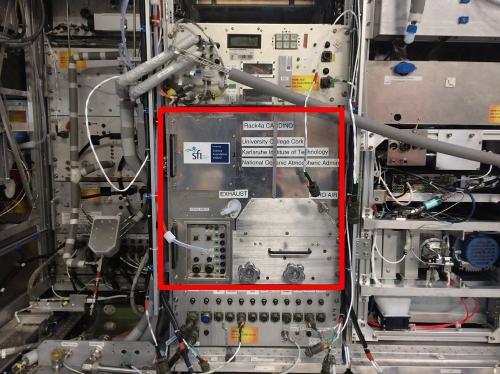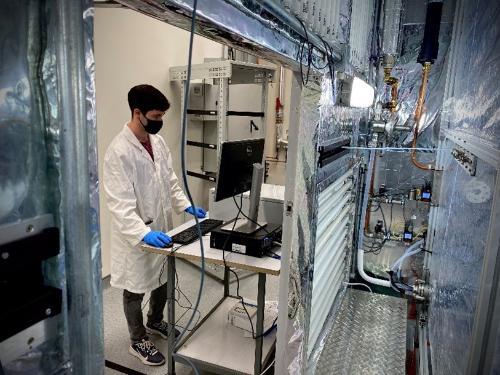Instrument and Sensor Development
On This Page
Introduction
The CRAC group has a productive history of developing spectroscopic instruments for atmospheric monitoring. In 2003, Andy Ruth and his collaborators invented the technique of Incoherent Broadband Cavity Enhanced Absorption Spectroscopy (IBBCEAS) [1]. IBBCEAS was a milestone in extending the use of optical cavities from monochromatic (laser) sources to broadband light sources such as arc lamps, LEDs, and supercontinuum sources. Broadband sources have lower photon densities than lasers, but can be used in combination with optical cavities and spectrographs to deliver richer spectral information than attainable with lasers. Selectivity to many atmospheric species is excellent and sensitivity is sufficiently high for atmospheric sensing [2,3]. Dean Venables joined CRAC at this time and was involved in the earliest adaption of IBBCEAS to atmospheric measurements.

Some of the first atmospheric applications include the detection of the NO3 radical [4,5], a key nocturnal oxidant,[image of spectrum] and nitrous acid, HONO [6,7], a precursor of OH, the dominant daytime atmospheric oxidant. IBBCEAS has also been used to study chemical species of marine origin, such as molecular iodine, I2 (emitted by brown macroalgae) and its reaction products, iodine monoxide, IO, and iodine dioxide, OIO [8,9].
Atmospheric simulation chambers have featured prominently in the group’s work [4,6]. Notable milestones include developing a 21 m optical resonator for the outdoor SAPHIR chamber at the Forchungszentrum Jülich in Germany [5,7] and participating in several international measurements intercomparisons [4,10,11].

The broadband optical cavity approach has been particularly fruitful in many atmospheric applications, whether in laboratory or simulation chamber studies, or in field campaigns. It has therefore been adopted by leading atmospheric groups in the UK (Cambridge), Germany (Heidelberg), China (USST, AOIFM), France (ULCO, LISA), USA (NOAA), among others. Other techniques (CE-DOAS, BB-CEAS, BB-CEES, or BB-ICOS) are either different names for the same approach or differ marginally in the spectral analysis approach taken.
Both together and separately, Andy Ruth and Dean Venables have continued to apply and adapt IBBCEAS and other spectroscopic methods. This work includes:
- Application of optical cavities with atmospheric simulation chambers [5-7,9-11].
- Application with Fourier transform spectrometers for high resolution spectroscopy [12]
- Use of long paths and open path configurations [13] [image of Mace Head systems]
- Sensing in the UV and deep-UV, including for detection of mercury and aromatic species [14,15]
- Application of the method to sensitive aerosol extinction measurements [11].
- Development of a LIDAR station in Cork [16].
- Laser induced plasma driven broadband cavity enhanced absorption spectroscopy [17].
- Surface application using broadband cavity-enhanced evanescent field approaches [18].

Spectroscopic instrument development work in CRAC. Highlights include a joint NOAA-KIT-UCC project to build a cavity ringdown (CRDS) spectrometer for airborne measurements of NO3, N2O5, NO2 and O3 as part of the CARIBIC project. Ongoing projects include the application of gain-switched frequency combs in the near IR [19], the incorporation of optical cavity spectrometers across the new IASC chamber, and development of a low cost sensor package using cavities and SLEDs to the detection of NO2.
Research Facilities
The Ruth and Venables groups have a good facilities for developing optical and spectroscopic techniques. These facilities include:
Laboratory Space
A 55 m2 chamber laboratory , a 30 m2 wet lab and 30 m2 instrument (dry) lab, a 100 m2 optics and spectroscopy lab with 5 optical benches, a 50 m2 spectroscopy and chamber lab in the Environmental Research Institute (ERI, Lee Road). Several offices are available for postgraduate students and post doctoral fellows.
Irish Atmospheric Simulation Chamber (IASC)
 This national facility, funded through SFI’s infrastructure call 2015, incorporates the latest developments in atmospheric chamber design and is equipped with cutting-edge instrumentation for trace gas and particle detection. It comprises a 25 m3 Teflon (FEP) chamber with thermalized enclosure, chamber air conditioning units, sample inlet systems (mass-flow controller manifold), 140 fluorescent UV lamps for photolysis. There is access to the inside of chamber which has a movable floor; feed-throughs for up to 10 optical ports for cavity systems (open path and extractive).
This national facility, funded through SFI’s infrastructure call 2015, incorporates the latest developments in atmospheric chamber design and is equipped with cutting-edge instrumentation for trace gas and particle detection. It comprises a 25 m3 Teflon (FEP) chamber with thermalized enclosure, chamber air conditioning units, sample inlet systems (mass-flow controller manifold), 140 fluorescent UV lamps for photolysis. There is access to the inside of chamber which has a movable floor; feed-throughs for up to 10 optical ports for cavity systems (open path and extractive).
A 2 m3 simulation chamber for marine halogen chemistry equipped with ports for spectrometers and other instruments is available in the ERI.
Atmospheric Monitoring Station
This insulated outdoor building (12 m2) includes a weather mast and outdoor facility is equipped with NOX and O3 monitors, and a PM2.5 BAM; The facility is run in collaboration with the Irish EPA and delivers quality assured data to the national air quality database in real-time via an internet hub as well as weather data to MetEireann.
A Raman LIDAR system is housed in a portacabin near the Kane building.
References
[1] S.E. Fiedler, A. Hese, A.A. Ruth*, "Incoherent broad-band cavity-enhanced absorption spectroscopy", Chem. Phys. Lett. 371 (2003) 284-294.
[2] A.A. Ruth*, S. Dixneuf, R. Raghunandan, "Broadband cavity-enhanced absorption Spectroscopy with incoherent light", in: "Cavity enhanced spectroscopy and sensing", Eds. G. Gagliardi and H.P. Loock, Springer Series in Optical Sciences, Vol. 179 (2014) 485-517. ISBN: 978-3-642-40002-5.
[3] W. Chen, D.S. Venables, M. Sigrist (Eds), Advances in Spectroscopic Monitoring of the Atmosphere, 1st Edition – 9 June 2021, Elsevier.
[4] D.S. Venables, T. Gherman, J. Orphal, J. Wenger, A.A. Ruth*, "High sensitivity in situ monitoring of NO3 in an atmospheric simulation chamber using incoherent broadband cavity-enhanced absorption spectroscopy", Env. Sci. Tech. 40 (2006) 6758-6763.
[5] H.-P. Dorn*, R.L. Apodaca, S.M. Ball, T. Brauers, S.S. Brown, J.N. Crowley, W.P. Dubé, H. Fuchs, R. Häseler, U. Heitmann, R.L. Jones, A. Kiendler-Scharr, I. Labazan, J. M. Langridge, J. Meinen, T.F. Mentel, U. Platt, D. Pöhler, F. Rohrer, A.A. Ruth, E. Schlosser, G. Schuster, A.J.L. Shillings, W. R. Simpson, J. Thieser, R. Tillmann, R. Varma, D.S. Venables, A. Wahner, "Intercomparison of NO3 radical detection instruments in the atmosphere simulation chamber SAPHIR", Atmos. Meas. Tech. 6 (2013) 1111-1140; previously Atmos. Meas. Tech. Discuss. 6 (2013) 303-379.
[6] T. Gherman, D.S. Venables, S. Vaughan, J. Orphal, A.A. Ruth*, "Incoherent broadband cavity-enhanced absorption spectroscopy in the near-ultraviolet: Application to HONO and NO2", Env. Sci. Tech. 42 (2008) 890-895.
[7] S. Dixneuf, A.A. Ruth*, R. Häseler, T. Brauers, F. Rohrer, H.-P. Dorn, "Detection of nitrous acid in the atmospheric simulation chamber SAPHIR using open-path incoherent broadband cavity-enhanced absorption spectroscopy and extractive long-path absorption photometry", Atmos. Meas. Tech. 15 (2022) 945-964.
[8] S. Dixneuf, A.A. Ruth*, S. Vaughan, R.M. Varma, J. Orphal, "The time dependence of molecular iodine emission from Laminaria digitata", Atm. Chem. Phys. 9 (2009) 823-829; previously Atm. Chem. Phys. Discuss. 8 (2008) 16501-16516.
[9] E.R. Ashu-Ayem, U. Nitschke, C. Monahan, J. Chen, S. B. Darby, P. D. Smith, C. D. O’Dowd, D. B. Stengel, D.S. Venables*, "Coastal Iodine Emissions. 1. Release of I2 by Laminaria digitata in Chamber Experiments", Environ. Sci. Technol. 46 (2012) 10413–10421.
[10] H. Fuchs, S.M. Ball, B. Bohn, T. Brauers, R. C. Cohen, H. P. Dorn, W. P. Dubé, J. L. Fry, R. Häseler, U. Heitmann, R. L. Jones, J. Kleffmann, T. F. Mentel, P. Müsgen, F. Rohrer, A. W. Rollins, A.A. Ruth, A. Kiendler-Scharr, E. Schlosser, A. J. L. Shillings, R. Tillmann, R. M. Varma, D.S. Venables, G. Villena Tapia, A. Wahner, R. Wegener, P. J. Wooldridge, S. S. Brown, "Intercomparison of measurements of NO2 concentrations in the atmosphere simulation chamber SAPHIR during the NO3Comp campaign", Atmos. Meas. Tech. 3 (2010) 21-37; previously Atmos. Meas. Tech. Discuss. 2 (2009) 2539-2586.
[11] R.M. Varma, S.M. Ball, T. Brauers, H.-P. Dorn, U. Heitmann, R.L. Jones, U. Platt, D. Pöhler, A.A. Ruth, A.J.L. Shillings, J. Thieser, A. Wahner, D.S. Venables*, "Light extinction by Secondary Organic Aerosol: An intercomparison of three broadband cavity spectrometers", Atmos. Meas. Tech. 6 (2013) 3115-3130, previously Atmos. Meas. Tech. Discuss. 6 (2013) 6685-6727.
[12] A.A. Ruth*, J. Orphal, S.E. Fiedler, "Cavity Enhanced Fourier Transform Absorption Spectroscopy using an Incoherent Broadband Light Source", Appl. Opt. 46 (2007) 3611-3616.
[13] R.M. Varma, D.S. Venables, A.A. Ruth*, U. Heitmann, E. Schlosser, S. Dixneuf, "Long optical cavities for open-path monitoring of atmospheric trace gases and aerosol extinction", Appl. Opt. 48 (2009) B159-B171.
[14] J. Chen, D. S. Venables*, "A broadband optical cavity spectrometer for measuring weak near-ultraviolet absorption spectra of gases", Atmos. Meas. Tech. 4 (2011) 425–436.
[15] M. Wang, R. Varma, D.S. Venables, W. Zhou, J. Chen*, "A demonstration of broadband cavity-enhanced absorption spectroscopy at deep-ultraviolet wavelengths: Application to sensitive real-time detection of the aromatic pollutants Benzene, Toluene, and Xylene" Anal. Chem. 94 (2022) 4286–4293.
[16] M.A.P. McAuliffe, A.A. Ruth*, "Typical tropospheric aerosol backscatter profiles for Southern Ireland: The Cork Raman LIDAR", Atm. Research 120-121 (2013) 334-342.
[17] B.P. Keary, A.A. Ruth*, "Time- and intensity-dependent broadband cavity-enhanced absorption spectroscopy with pulsed intra-cavity laser-induced plasmas", Opt. Express 27 (2019) 36864-36874.
[18] A.A. Ruth*, K.T. Lynch, "Incoherent broadband cavity-enhanced total internal reflection spectroscopy of surface-adsorbed metallo-porphyrins", Phys. Chem. Chem. Phys. 10 (2008) 7098-7108.
[19] S. Chandran, A.A. Ruth*, E.P. Martin, J.K. Alexander, F.H. Peters, P.M. Anandarajah,"Off-axis cavity-enhanced absorption spectroscopy of 14NH3 in air using a gain-switched frequency comb at 1.514 mm", Sensors 19 (2019) 5217.
